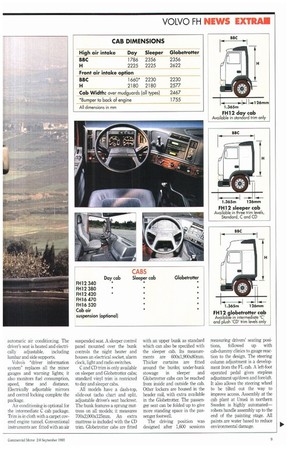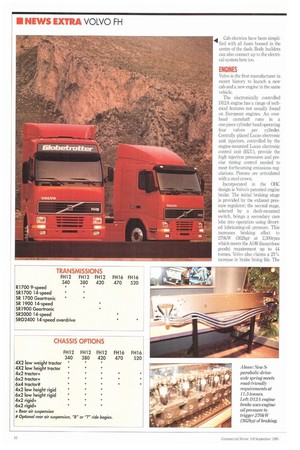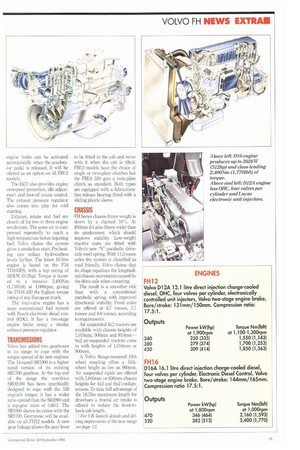Volvo hasn'tffluc e a out with its tong-awaite range—there's a
Page 12

Page 13

Page 14

Page 15

If you've noticed an error in this article please click here to report it so we can fix it.
lighter, slepkertabictej the electrMill); controlled OH _ engine-At almost eclipses the revamped 16-litre lump's European torque record.
Volvo launches its FH heavy V truck range in the UK this week as the culmination of a seven-year, £600m development programme. The range features a brand new cab and all-new 12.1litre electronically controlled overhead-cam engine.
The modified 16-litre engine used in the FH16 pushes power output to 382kW (512hp). With the new 250kW (335hp) rating for the 12-litre D12A. engine the 10litre option has been dropped, but continues in the FL10.
Volvo claims that the new engines are 10% more fuel effi dent than their predecessors in the F12 and F16.
The new cab is 30% lighter than the F cab with better streamlining that is said to reduce drag by 20%. Further weight has been saved by the use of aluminium fuel and air tanks as standard: an S-shaped steel parabolic spring is another inovation.
CABS
The FH chassis is clad with three cab variants and three trim levels. Day, sleeper and high-roof Globetrotter cabs will suit a vari ety of operational needs. All sheet metal is galvanised on both sides and HSS high-strength steel is used to reinforce construction and reduce weight. Doors are fitted with reinforcing bars to improve crash protection. Other safety features include a steering column which yields under impact, specially designed pedals, cab reinforcement at driver's knee height and seat belts.
External plastic panels are used, mainly in the grille and step well areas. All plastic panels are marked for re-cycling The Globetrotter high-roof cab has an all steel roof section. At 840kg complete, the day cab is some 125kg lighter than the old F day cab; the sleeper is some 100kg lighter at 955Icg.
Volvo claims a Cd figure of 0.55 for a complete sleepercabbed vehicle with all aerodynamic aids. This compares with 0.69 for a similarly equipped F range vehicle. The FH has a choice of cab suspensions: fourpoint coil springs or self-levelling four-point air.
Inside, the top level of CD trim includes leather upholstery, wood-effect dash inserts and automatic air conditioning The driver's seat is heated and electrically adjustable, including lumbar and side supports.
Volvo's "driver information system" replaces all the minor gauges and warning lights; it also monitors fuel consumption, speed, time and distance. Electrically adjustable mirrors and central locking complete the package.
Air conditioning is optional for the intermediate C cab package. Trim is in cloth with a carpet covered engine tunnel. Conventional instruments are fitted with an air suspended seat. A sleeper control panel mounted over the bunk controls the night heater and houses an electrical socket alarm clock, light and radio switches.
C and CD trim is only available on sleeper and Globetrotter cabs; standard vinyl trim is restricted to day and sleeper cabs.
All models have a dash-top, slide-out tacho chart and split, adjustable driver's seat backrest. The bunk features a sprung mattress on all models; it measures 700x2,000x125trim. An extra mattress is included with the CD trim. Globetrotter cabs are fitted with an upper bunk as standard which can also be specified with the sleeper cab. Its measurements are 600x1,900x80rnm. Thicker curtains are fitted around the bunks; under-bunk stowage in sleeper and Globetrotter cabs can be reached from inside and outside the cab. Other lockers are housed in the header rail, with extra available in the Globetrotter. The passenger seat can be folded up to give more standing space in the passenger footwell.
The driving position was designed after 1,600 sessions measuring drivers' seating positions, followed up with cab-dummy clinics to gauge reaction to the design. The steering column adjustment is a development from the FL cab. A left-foot operated pedal gives stepless adjustment up/down and fore/aft. It also allows the steering wheel to be tilted out the way to improve access. Assembly at the cab plant at Umea in northern Sweden is highly automated— robots handle assembly up to the end of the painting stage. All paints are water based to reduce environmental damage.
adi Cab electrics have been simplified with all fuses housed in the centre of the dash. Body builders can also connect up to the electrical system here too.
ENGINES
Volvo is the first manufacturer in recent history to launch a new cab and a new engine in the same vehicle.
The electronically controlled D12A engine has a range of technical features not usually found on European engines. An overhead camshaft runs in a one-piece cylinder head operating four valves per cylinder. Centrally placed Lucas electronic unit injectors, controlled by the engine-mounted Lucas electronic control unit (ECU), provide the high injection pressures and precise timing control needed to meet forthcoming emissions regulations. Pistons are articulated with a steel crown.
Incorporated in the OHC design is Volvo's patented engine brake. The initial braking stage is provided by the exhaust pressure regulator; the second stage, selected by a dash-mounted switch, brings a secondary cam lobe into operation using diverted lubricating-oil pressure. This increases braking effect to 270kW (362hp) at 2,300rpm which meets the ADR (hazardous goods) requirement up to 44 tonnes. Volvo also claims a 25% increase in brake lining life. The engine brake can be activated automatically when the accelerator pedal is released. It will be offered as an option on all FH12 models The ECU also provides engine overspeed protection, idle adjustment and foot-off cruise control. The exhaust pressure regulator also comes into play for cold starting.
Exhaust, intake and fuel are closed off for two to three engine revolutions. The same air is compressed repeatedly to reach a high temperature before injecting fuel; Volvo claims the system gives a smokeless start. Pre-heating can reduce hydrocarbon levels further. The latest 16-litre engine is based on the F16 TD163ES, with a top rating of 382kW (512hp). Torque is boosted to a massive 2,400Nm (1,7701bft) at 1,000rpm, giving the FE116 520 the highest torque rating of any European truck.
The four-valve engine has a more conventional fuel system with Bosch electronic diesel control (EDC). It has a two-stage engine brake using a similar exhaust pressure regulator.
TRANSMISSIONS
Volvo has added two gearboxes to its range to cope with the torque spread of its new engines. The 14-speed SR1900 is a higher rated version of its existing SR1700 gearbox. At the top end of the range the overdrive SR02400 has been specifically designed to cope with the 520 engine's torque; it has a wider ratio spread than the SR2000 and a top-gear ratio of (180:1. The SR1900 shares its ratios with the SR1700. Geartronic will he available on all F1112 models A new gear linkage allows the gear lever
to be fitted in the cab and move with it when the cab is tilted. FH1.2 models have the choice of single or twin-plate clutches but the FH16 520 gets a twin-plate clutch as standard. Both types are equipped with a lubricationfree release bearing fitted with a sliding plastic sleeve.
CHASSIS
F1-1 Series chassis frame weight is down by a claimed 10%. At 850mm it's also 50mm wider than its predecessor, which should improve stability Low-weight tractive units are fitted with Volvo's new "5" parabolic driveaxle steel spring. With 11.5-tonne axles the system is classified as road friendly. Volvo claims that its shape equalises the longitudinal chassis movements caused by the drive axle when cornering.
The result is a smoother ride than with a conventional parabolic spring, with improved directional stability Front axles are offered at 6.7 tonnes, 7.1 tonnes and 8.0 tonnes, according to requirements.
Air suspended 4x2 tractors are available with chassis heights of 1,010mm, 900mm and 810mm6x2 air-suspended tractors come in with heights of 1,010mm or 900mm.
A Volvo flange-mounted fifth wheel coupling offers a fifthwheel height as low as 960mm. Air suspended rigids are offered with 1,040mm or 850mm chassis heights for 4x2 and 6x2 configurations. To take full advantage of the 18.35m maximum length for drawbars a frontal air intake is offered to reduce the front-toback cab length.
For UK launch details and driving impressions of the new range seepage 12,












































































































